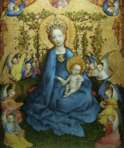Cologne School

Cologne School
The Cologne School of painting, a prominent German artistic movement, flourished in the medieval city of Cologne and the Lower Rhine region, mainly from 1300 to 1550. This period was an important epoch in the history of Lower Rhine art, characterized by the adoption of Old French artistic ideals and the distinctive Eikean style, characterized by elongated figures, graceful gestures, and complex iconography.
The artists of the Cologne School were known for their workshops in the most important geographical area of Old Cologne, known as Schildergasse. They made significant contributions to the rich commercial and cultural landscape of Cologne, a city beloved by emperors and popes and renowned for its cosmopolitan population of painters, sculptors, jewelers, and art collectors.
One of the most prominent representatives of this school was Stephen Lochner, who worked around 1442-51. His works are famous for their mystical religious themes and are considered the pinnacle of artistic achievement of the Cologne School. Lochner's works display the unique characteristics of the school, in which spiritual depth is intertwined with artistic subtlety.
Today, the legacy of the Cologne School of painting continues to interest collectors, auctioneers and experts in the field. Its influence and historical significance make it an essential study in understanding Western art movements of the premodern period.
It is important for collectors and enthusiasts interested in the Cologne School of painting to keep abreast of new sales, auction events and discoveries in the field. By subscribing to our updates, you will have access to the latest information and opportunities related to this influential art movement.
| Country: | Germany |
|---|---|
| Start of the period: | XIV century |
| End of the period: | XV century |